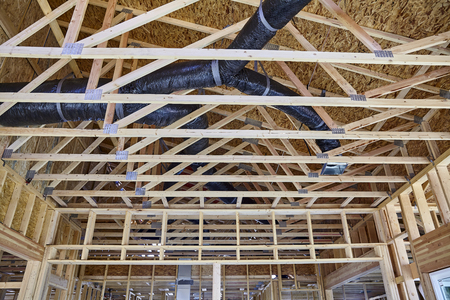Image copyright: jaimages / 123RF Stock Photo
Not all roofs are alike and whether you’re building a home from scratch or looking at having a roof retrofitted, it is a good idea to understand the many functions of a roof and what roof types (e.g. hip roof, gable roof, flat roof, dome, etc.) are best suited to your project.
Your choice of roofing should depend on many different factors including:
- physical protection from wind, rain and snow
- stability
- available space
- ventilation
- heat and energy efficiency
- light
- appearance
- cost
- complexity
To help you to make a decision, we have created this new series all about roof types. The first in the series is the hip roof.
What is a hip roof?
A hip roof (or hipped roof) is a roof which slopes on all four sides into either a pyramid or, more commonly, a triangular prism with a ridge along its centre. A simple hip roof contains two triangle sides (hip ends) and two polygons.
The advantages of a hip roof
Compared to a gable roof, which can suffer in wild weather, a hipped roof provides excellent protection from the wind, rain and snow. However, attention must be paid to the angle of the faces if you live in an area prone to high winds, such as exposed coastal regions. In such cases, the angle of the sides should always be more than 35 degrees to avoid the risk of uplift. Shallower slopes can cause the hip roof to act like an aeroplane wing, trying to lift off in strong winds!
A hip roof is one of the most stable and sturdy types of roof you can choose being self-bracing with all four sides sloping in towards the centre. A hip roof is suitable for all sorts of different floor plans and its even edges make fitting rainwater goods quite simple.
A hip roof provides good ventilation and can be extremely energy-efficient if constructed and insulated well. Hip roofs are also popular due to their appearance, being regularly seen on cottages and bungalows.
The disadvantages of a hip roof
The main disadvantage of hip roofs is their cost. a lot of materials are needed to build a hip roof and the complex construction of the rafters and trusses is also labour intensive meaning high labour costs. Some people are tempted to cut down costs by employing cheaper roofers but this is often false economy as poor construction can lead to leaking ridges and other problems.
Another issue with hip roofs can be the lack of flexibility within the structure. Unlike a gable roof, which can easily incorporate a window on the end, a hip roof will need to be designed at the outset to incorporate a dormer as alterations later on will be very expensive.
Variations on hip roofs
There are various different types of hip roof that may be of interest depending on your roofing needs. These include:
- Cross-hip roofs – These are a combination of two hip roofs with the ridges at right-angles to one another. The joins between the hip roofs are called valleys.
- Half-hipped roofs – This is basically a hip on top of a gable end which is constructed by shortening the hip ends in relation to the sides. It is a popular design in the South East.
- Gablet – This is a small gable on top of a hip roof.
- Tented roof – A steep angled hipped roof ending in a point (common on churches)
What other roofs would you like to know more about? Leave a response in the comments and we will do the research.
